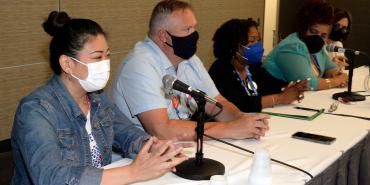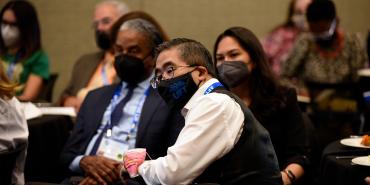Four AFT leaders shared their experiences growing community schools at a breakfast session Saturday, and despite the early hour, the energy in the room was palpable. Each leader zealously advocated for these community hubs, where services such as healthcare, food pantries, housing assistance and more are available, ensuring students’ basic needs are met so that they can focus on learning. And each described the challenges and successes they experienced as they initiated and now sustain community schools in their districts.
All agreed that deep involvement of the communities themselves is crucial. In Los Angeles, where community schools are now written into the union contract and fully funded by the district, United Teachers Los Angeles began with listening sessions to hear what community members most wanted in the schools.
“Folks said, ‘We want something different at our schools,’” said Cecily Myart-Cruz, president of UTLA. “So we started to build a platform around that.” Then, when UTLA went on strike in 2019 to improve learning and working conditions, the union refused to settle without contract language supporting community schools. Eventually, UTLA won 30 fully funded community schools, said Myart-Cruz. “It wasn’t a top-down model. It was actually one that was grass-roots led.”
In New York City, union leadership got involved with community schools about 10 years ago with a visit to Cincinnati, where AFT-affiliated community schools were thriving. Again, it was a “bottom up” endeavor where “folks get a say in what they want,” said Karen Alford, United Federation of Teachers’ vice president for elementary schools. UFT organizers—who were keenly aware that students and their families had unmet needs—started the effort themselves and eventually shared its success with the city’s board of education, advocating for more. From a modest six community schools, the UFT now boasts a network of 30.
Fighting “for” in addition to “against” has worked well, panelists agreed. “We were fighting so many different things,” said Jessica Tang, president of the Boston Teachers Union. “I realized we had to stand for something too.” Tang said community schools allowed students, educators and communities to define their assets as well as their needs, create partnerships and tap into resources.
In Texas, educators were fighting against flawed value-added metrics, among other things—but, said AFT Texas President Zeph Capo, activists were constantly being asked, “If this isn’t it, what are you going to do?” So the union began investigating what would work better. “That’s when we started looking at community schools.”
The proof of community school success is everywhere, including among AFT leadership. AFT Executive Vice President Evelyn DeJesus told participants that her community school “saved my life,” helping her with eyeglasses for her daughters and health benefits for her family. “I am an advocate 100,000 percent on community schools,” she said.
“We are really dedicated to leaning into this,” said AFT President Randi Weingarten. “This is pretty much the most important educational and social strategy that we can have that will help kids thrive.” It’s also a great way to push back on privatization, by tuning in to what parents and communities really need, and then providing it.
The union has already played a crucial role in building community schools, by building coalitions that strengthen the movement, advocating for supportive legislation and providing grants to help locals launch and support their own initiatives. Now that commitment is codified in a resolution that passed today pledging to expand the number of community schools the AFT supports from 700 to 2,500 and resolving to call on policymakers at every level to fund and support community schools.
[Virginia Myers/photos by Michael Campbell]


